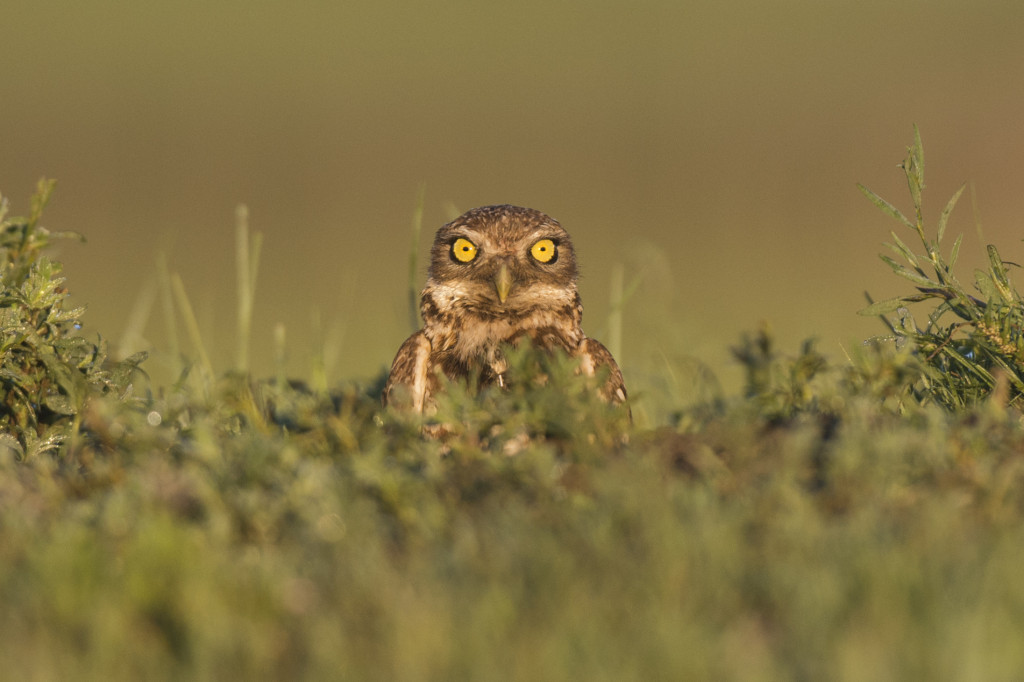
By Olivia DaRugna
Burrowing owls, as their name suggests, nest in underground burrows that were excavated by semi-fossorial animals, such as ground squirrels, prairie dogs and badgers. Not surprisingly, burrowing owls often inhabit black-tailed prairie dog colonies during the breeding season in Nebraska. After laying eggs, the parents incubate the eggs for about a month, and young birds remain near the nesting burrow for at least another month. Their use of underground burrows, as well as their high activity during the daytime hours, make them unique among owl species in North America.
According to Birds of Nebraska –Online, burrowing owls were once a common breeder throughout the state. However, the owls are now mostly absent from the farmed and developed eastern part of the state. In Nebraska, burrowing owls are listed as a Tier I Species of Greatest Conservation Need and listed as state imperiled in the Nebraska Natural Legacy Project.
Threats to burrowing owls include the loss of habitat due declines in prairie dog colonies and short open grasslands, as well as plague, wind energy development and the negative impacts of insecticides on their food source, including insects, such as grasshoppers, and other small animals, such as lizards and mice.
Burrowing owls are most numerous in the panhandle, where black-tailed prairie dog colonies (a Tier II at-risk species in Nebraska) are still common. To better understand burrowing owls in north-central Nebraska, Jason Thiele, a coordinating wildlife biologist, led a study to document nesting pairs of burrowing owls at locations in the Keya Paha Biologically Unique Landscape (Thiele et al., 2021). Results from this survey showed a much more substantial number of burrowing owls breeding in the area.
The close association burrowing owls have to active prairie dog colonies could be explained by a few different factors. Prairie dogs create and maintain many different burrows, which in turn provides suitable owl nest sites and escape routes from predators. Additionally, the shorter vegetation in the colonies may allow the owls to easily see approaching predators. As extra backup, owls may hear the prairie dogs’ warning call when a predator is near.

Viewing Tips
Prairie dog colonies offer the best chance for viewing burrowing owls, especially in western Nebraska. Although they can be viewed throughout the day, they are most active during mornings and early evenings. Despite this daytime activity, these birds tend to stay close to the ground, and their sandy color can disguise them well among vegetation and prairie dog mounds.
To spot burrowing owls, use binoculars or a spotting scope to scan through the prairie dog colony, and look for the pint-sized owl with long legs and big, yellow eyes. Be sure to check nearby fence posts for perching adults, too. They may be viewed running along the ground or flying low to hunt for insects and small animals.
July can be a great time to look for burrowing owls in Nebraska. The young begin to appear after spending their first two weeks in the burrow, and they are mostly brown on the back with a buffy-yellow belly and chest. You may view them standing together near the nest burrow or even see them play-hunt jumping on each other or on the prey parents bring to them. Burrowing owls are migratory, and by late summer through mid-October, they begin to disperse from their breeding areas and head south to their wintering grounds.
Burrowing owls can be a great animal for the whole family to observe and enjoy. While they may appear to tolerate a person’s presence, it is important to remember to watch them from a distance and keep the visit short to prevent disturbing this at-risk species, especially during nesting season. They may bob their heads and avoid hunting or even leave their nest area if they feel nervous by a person’s presence. Binoculars or viewing scopes are essential to enjoying the birds’ natural behavior from a safe distance.
